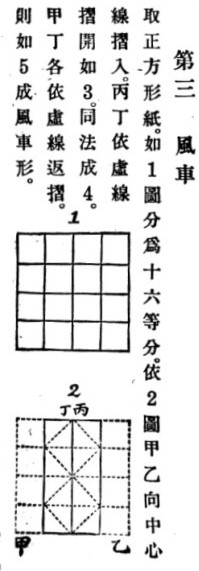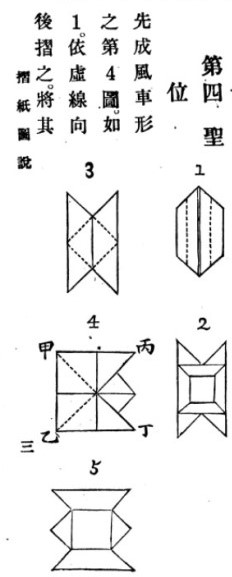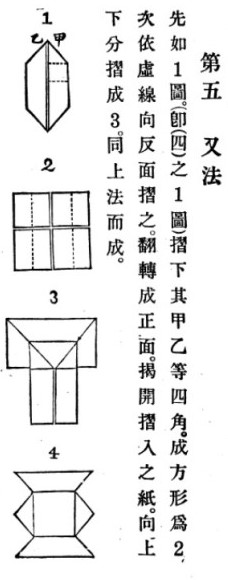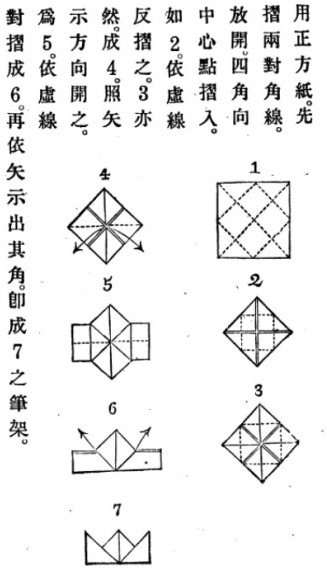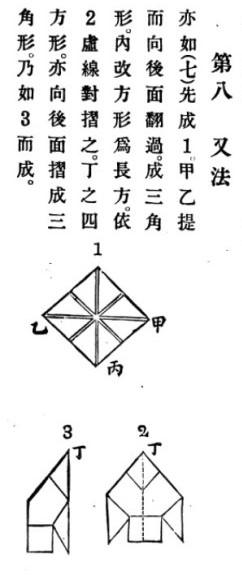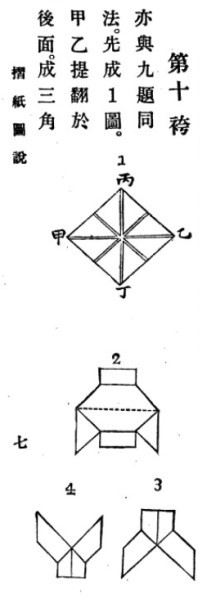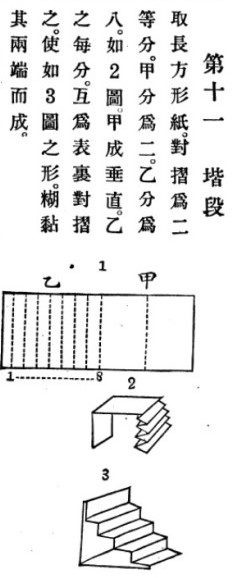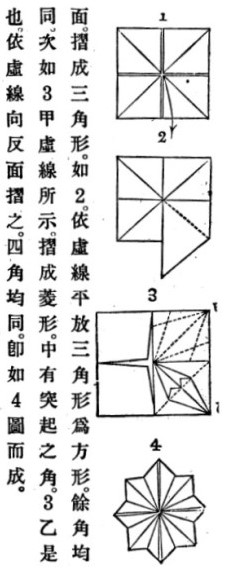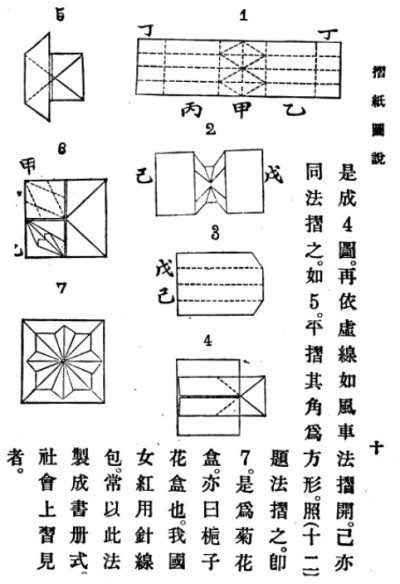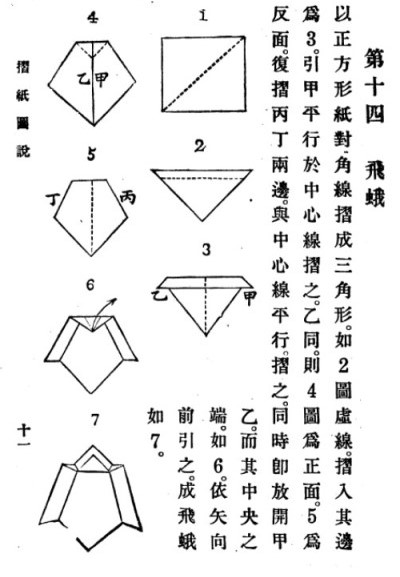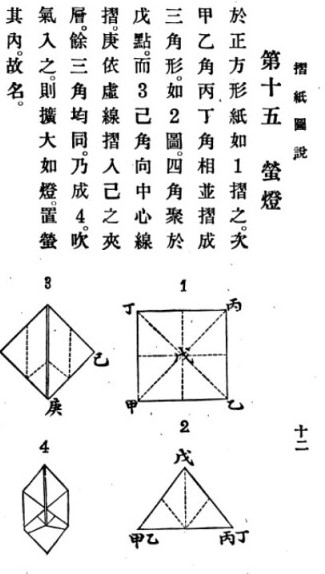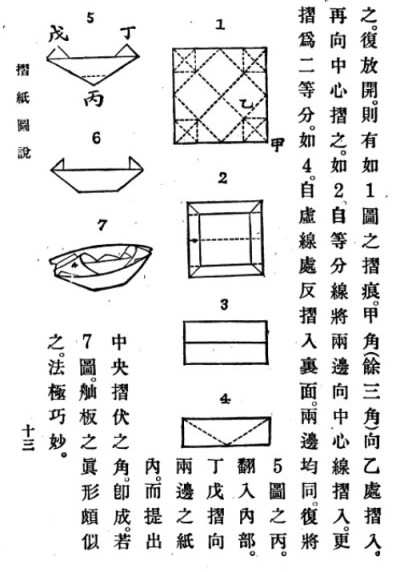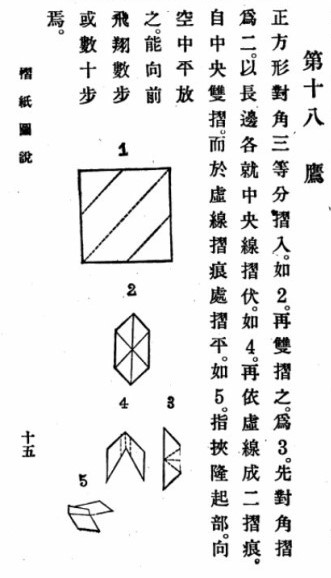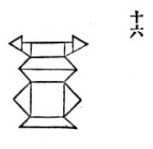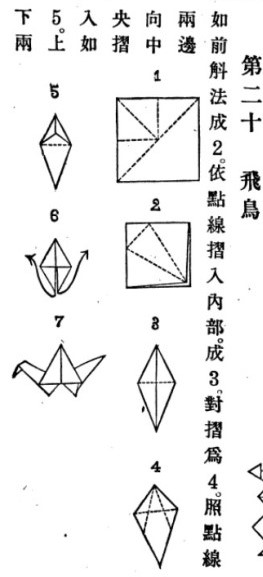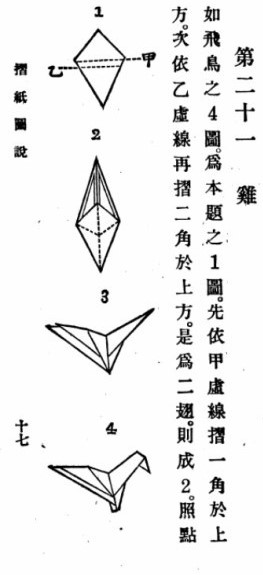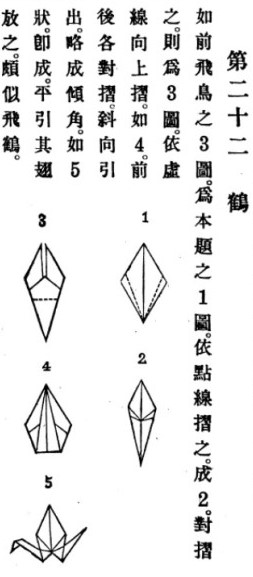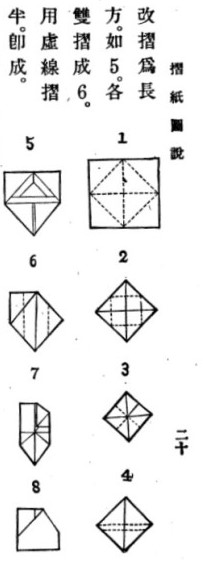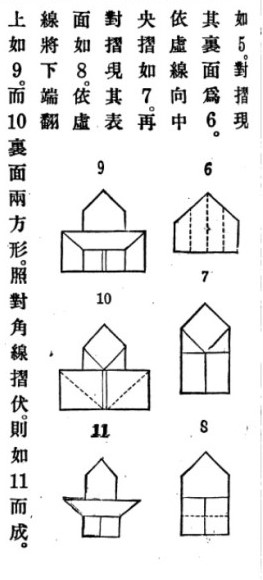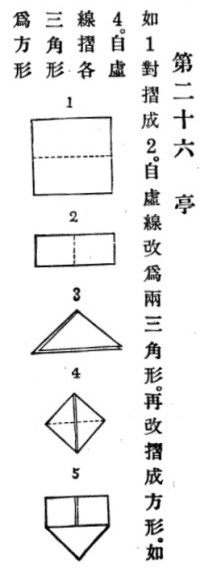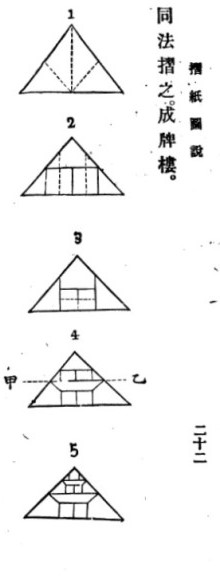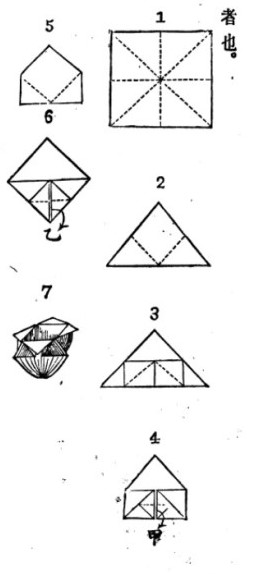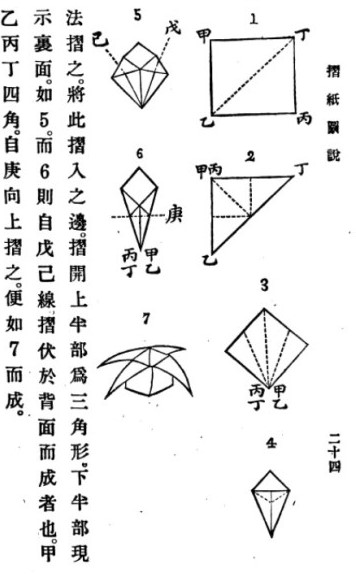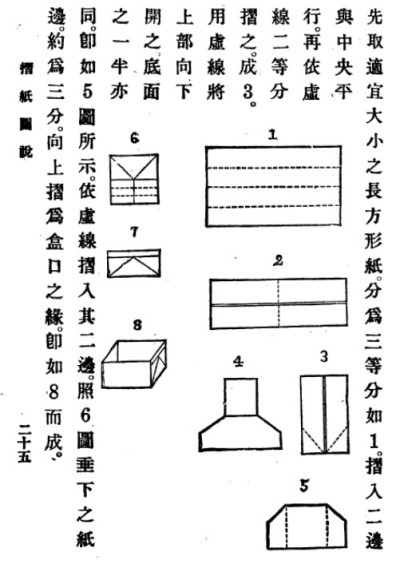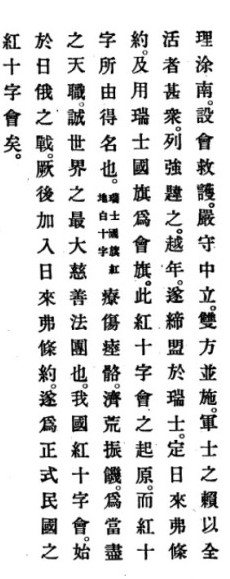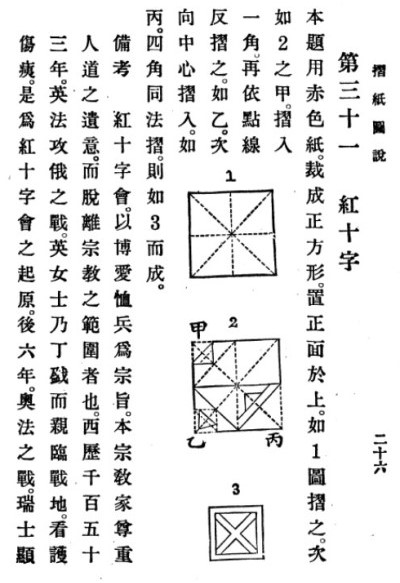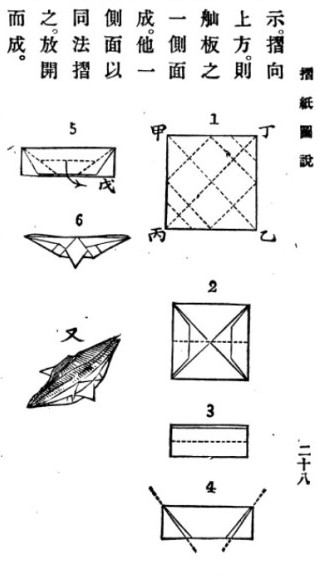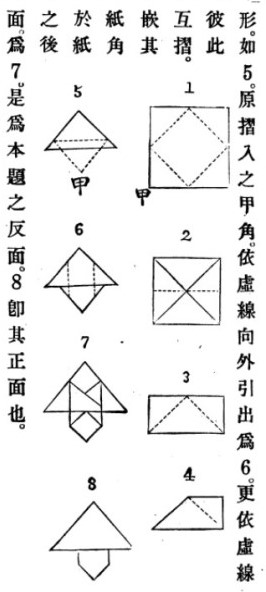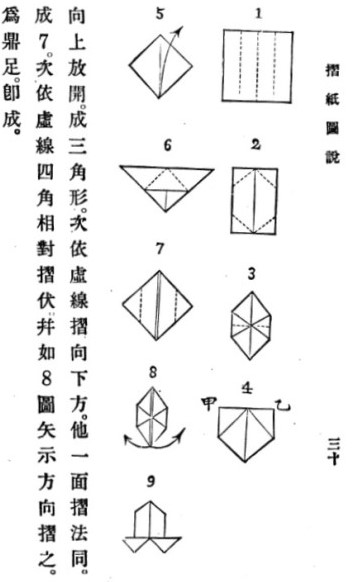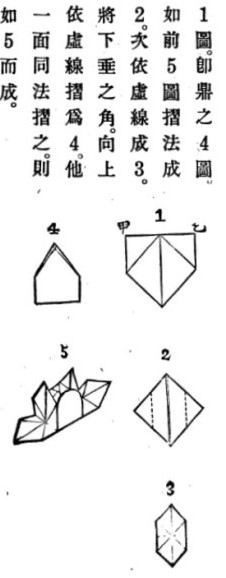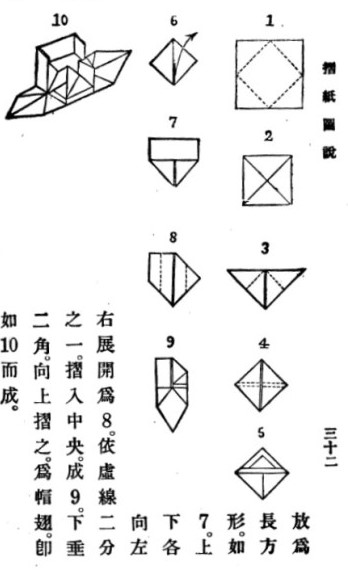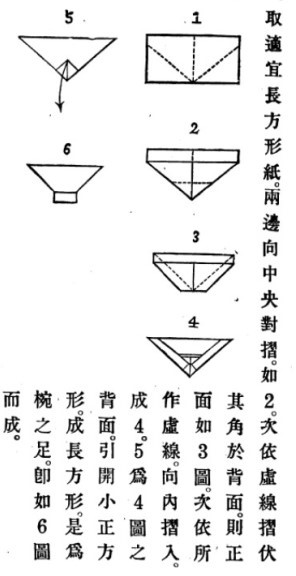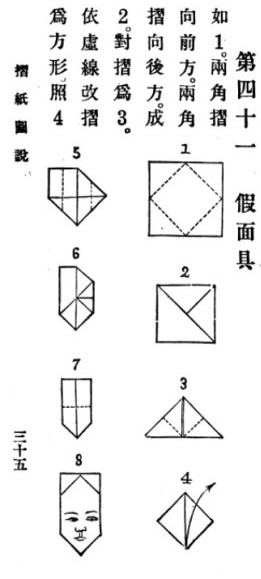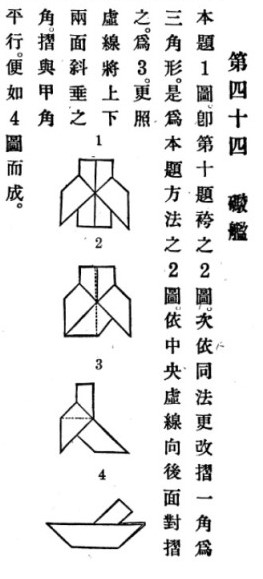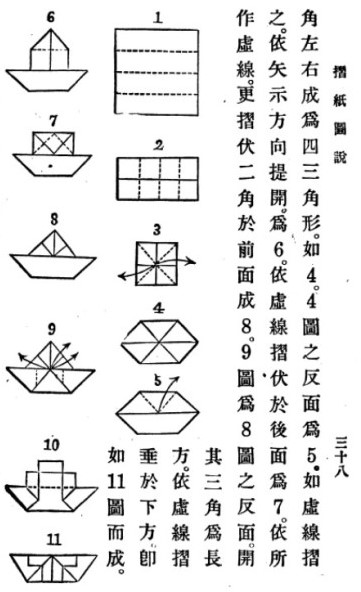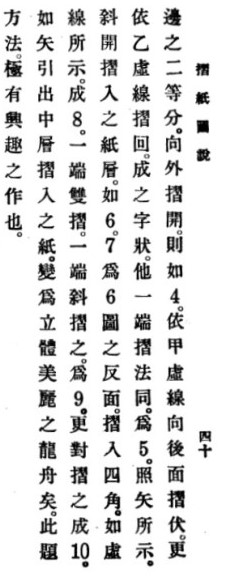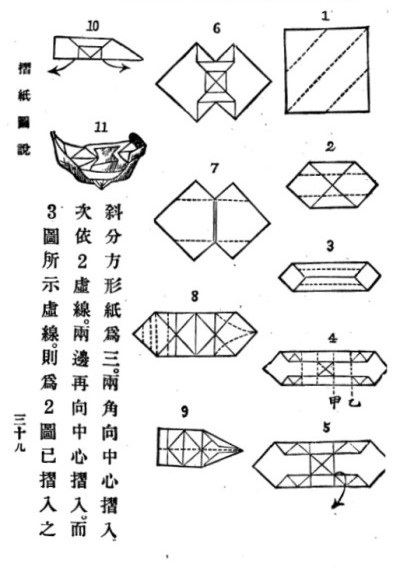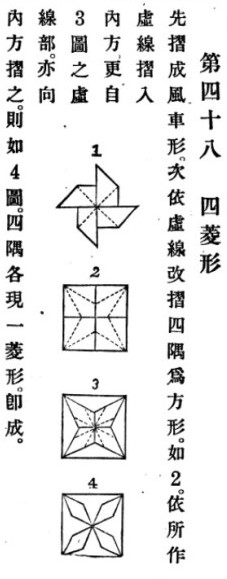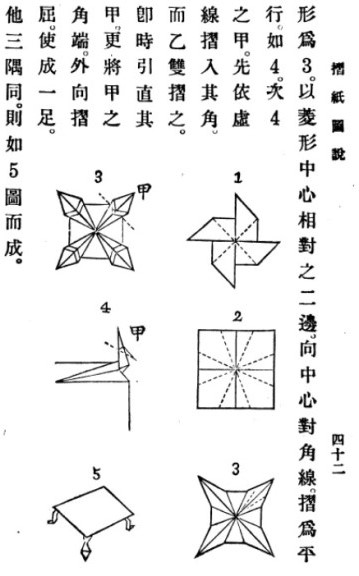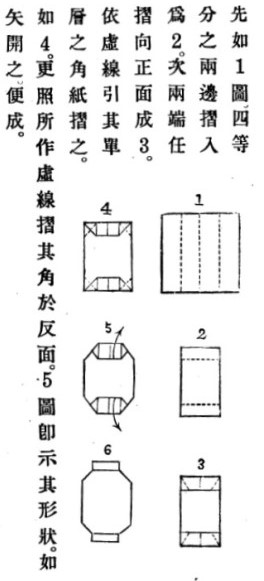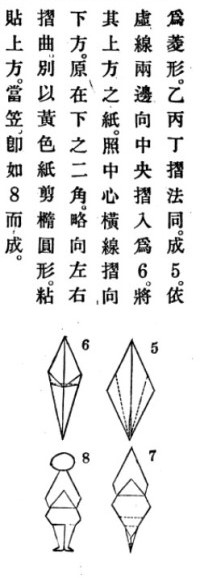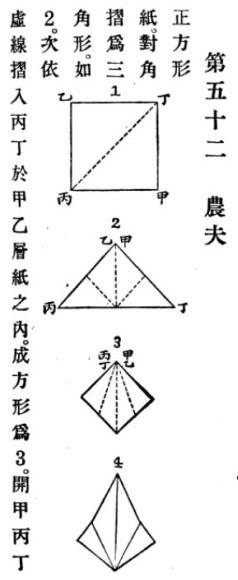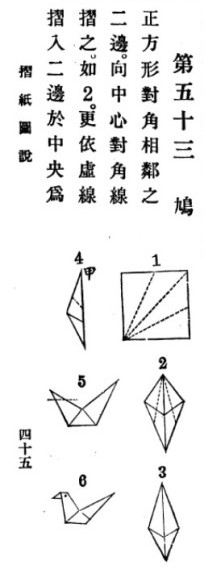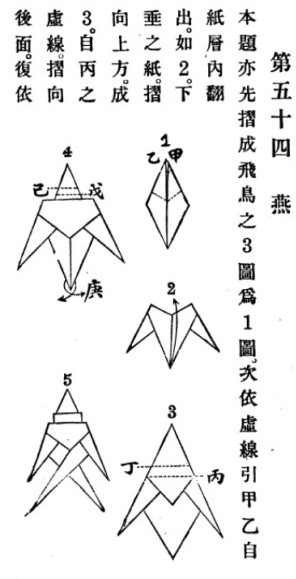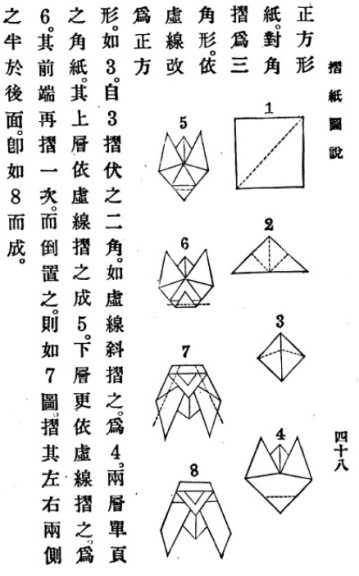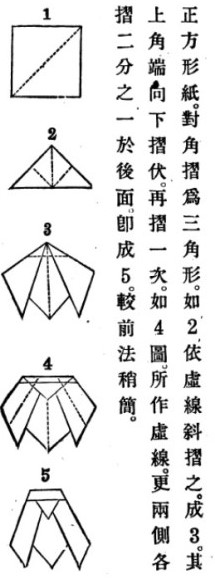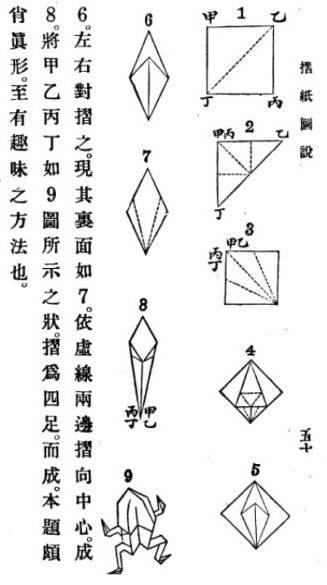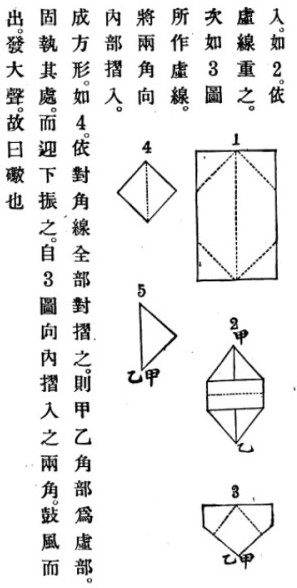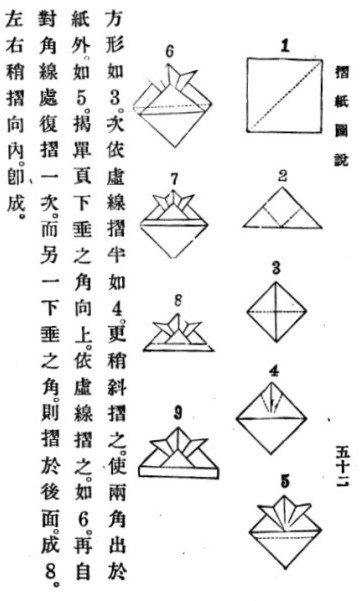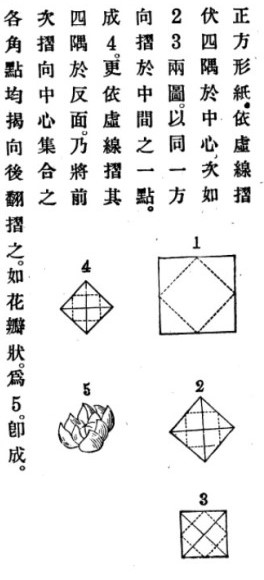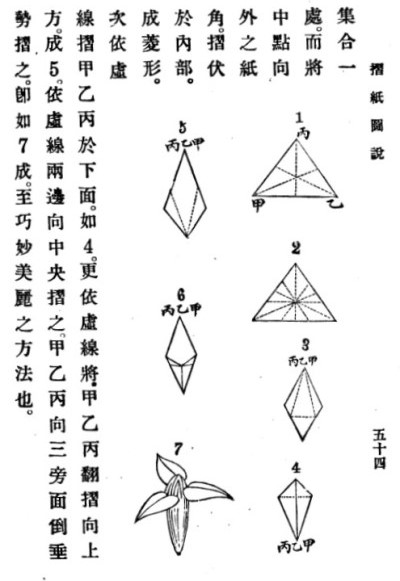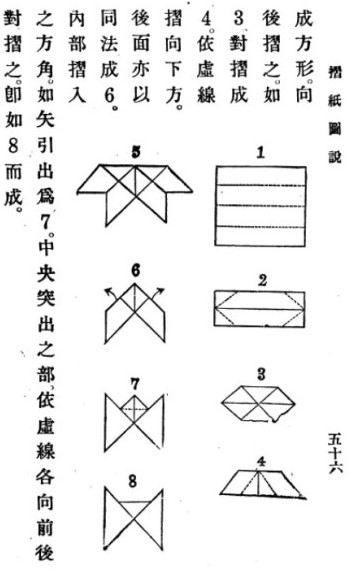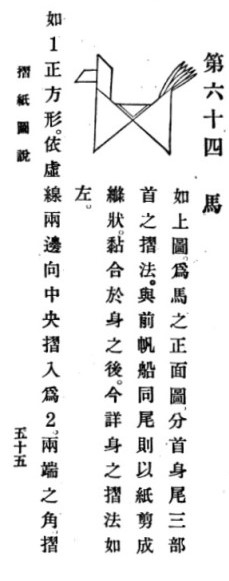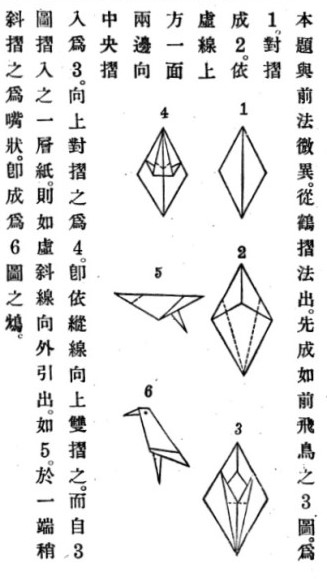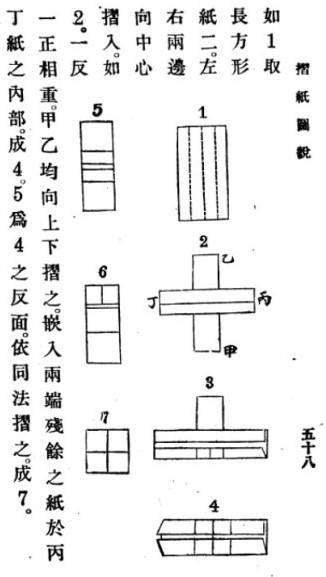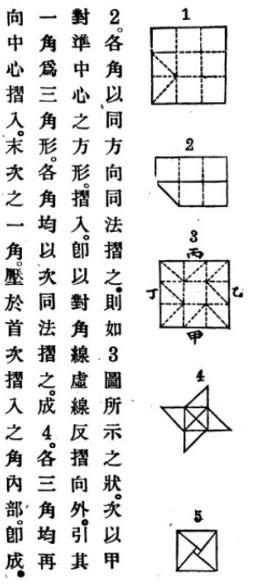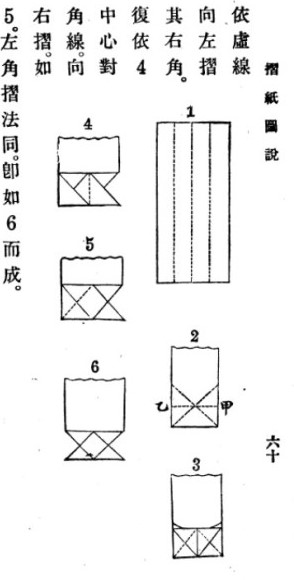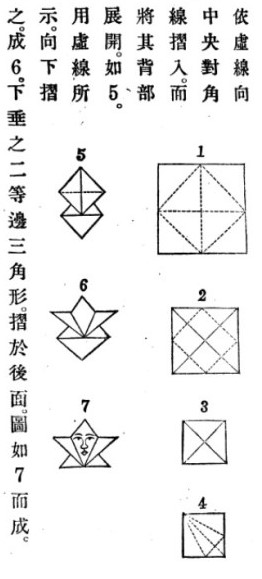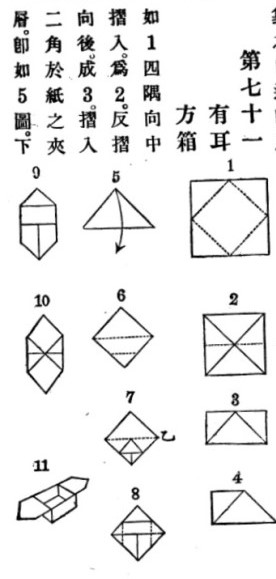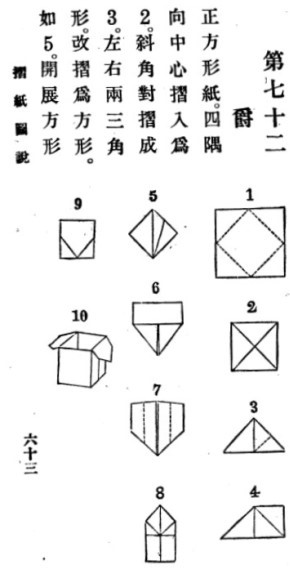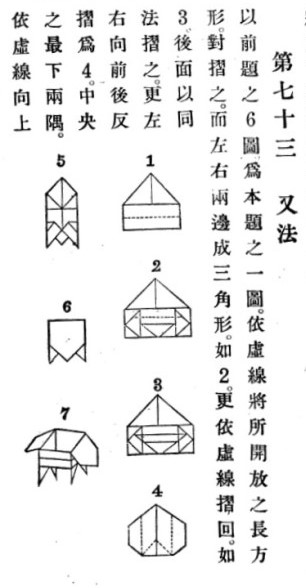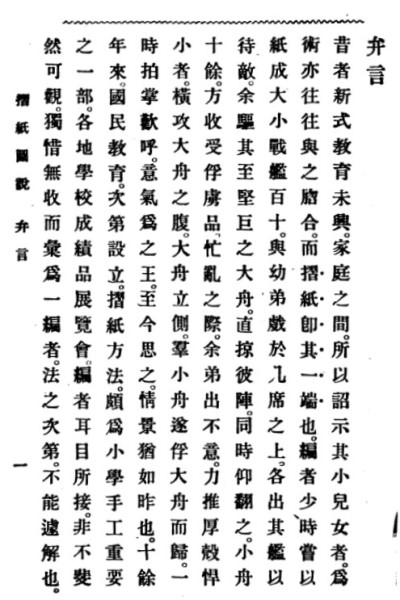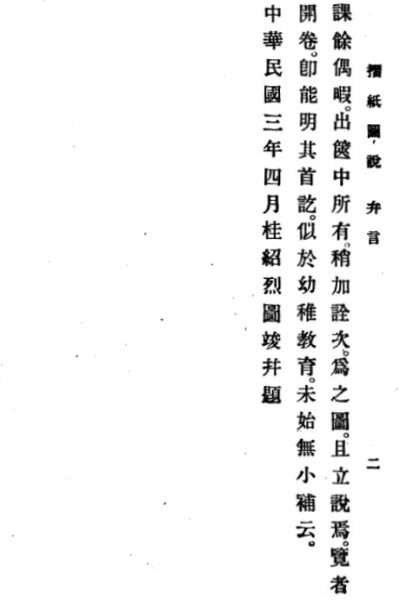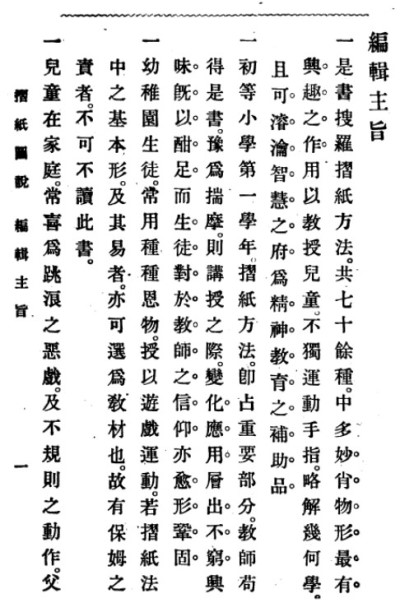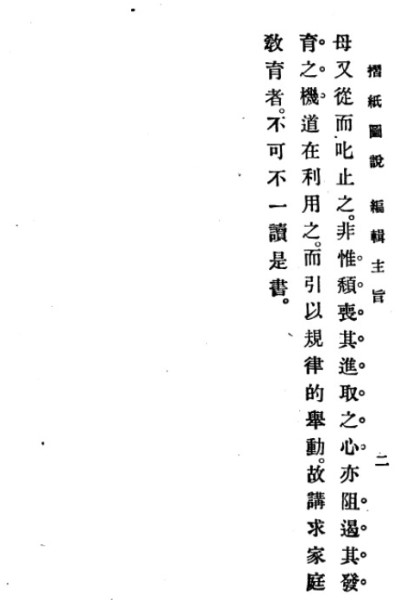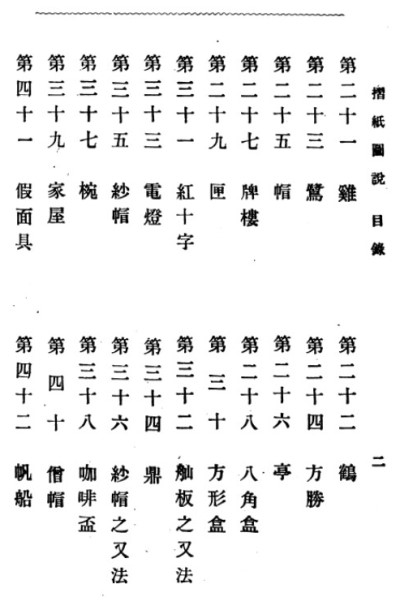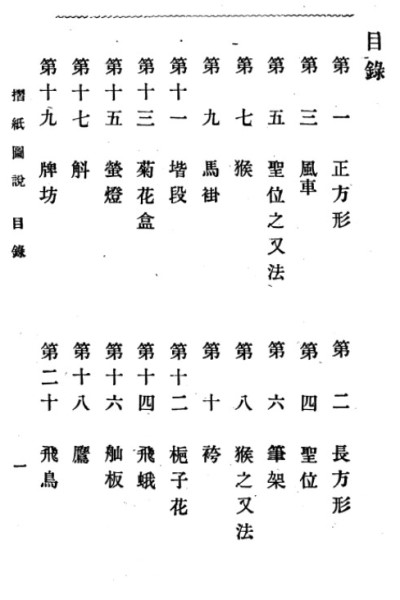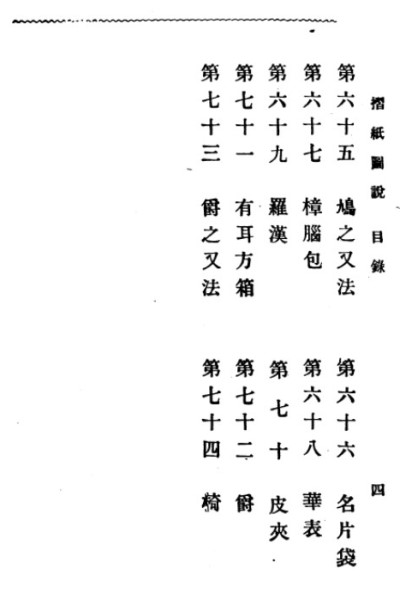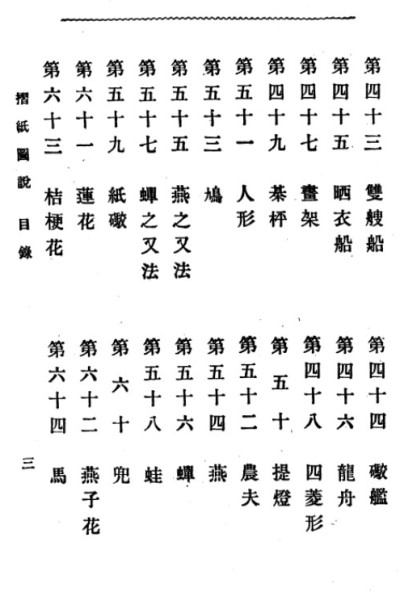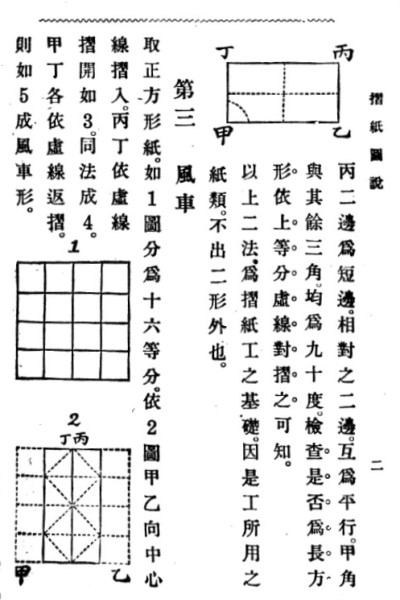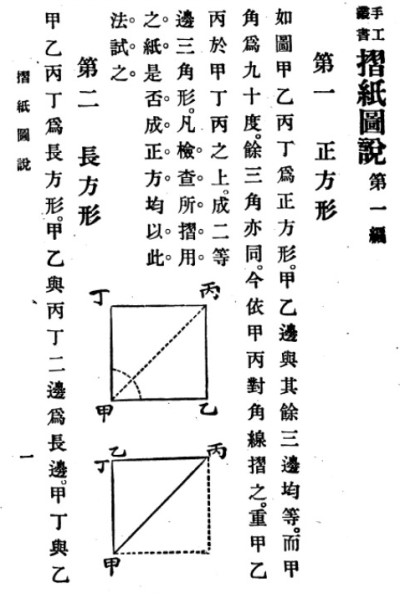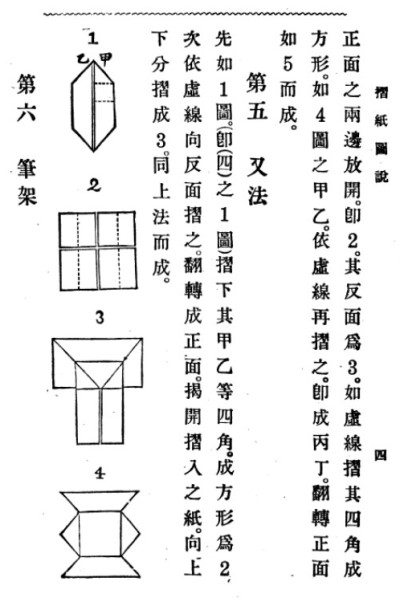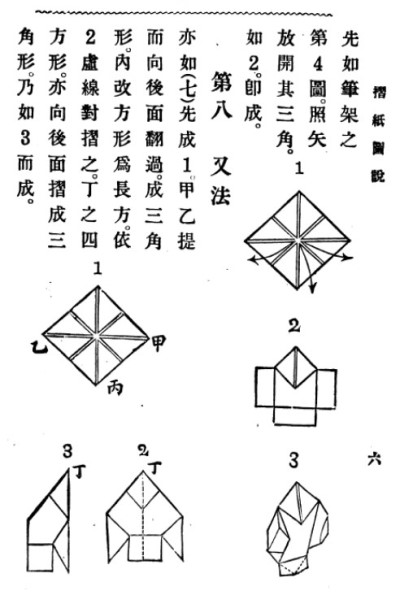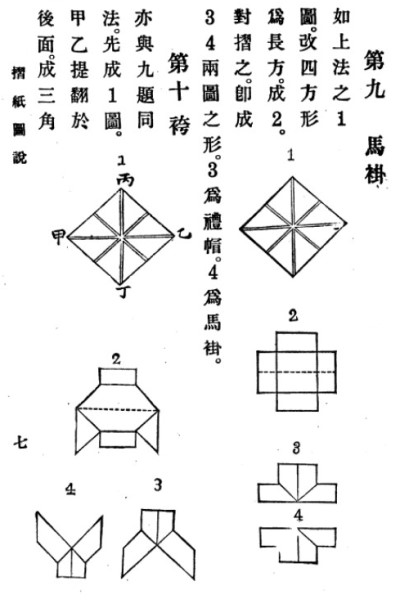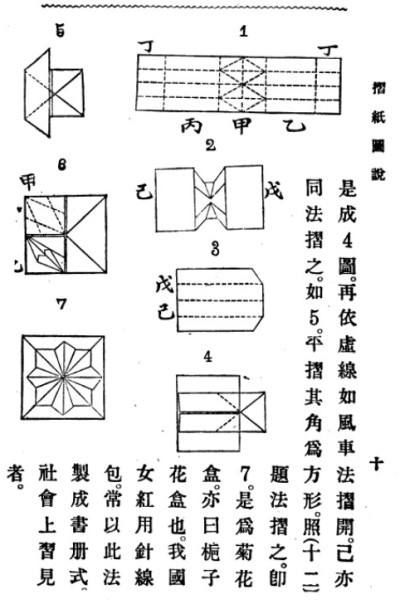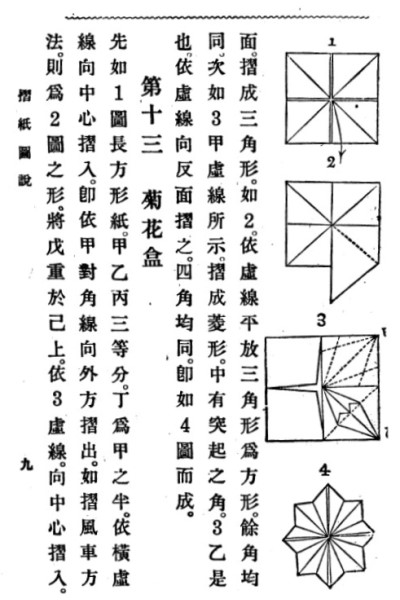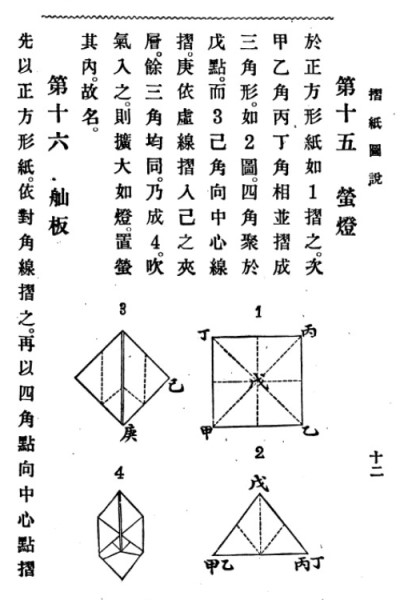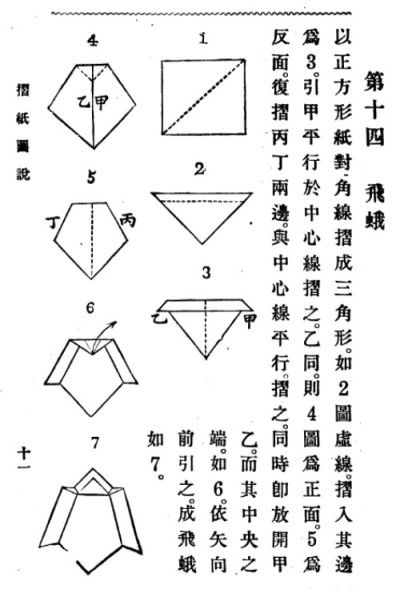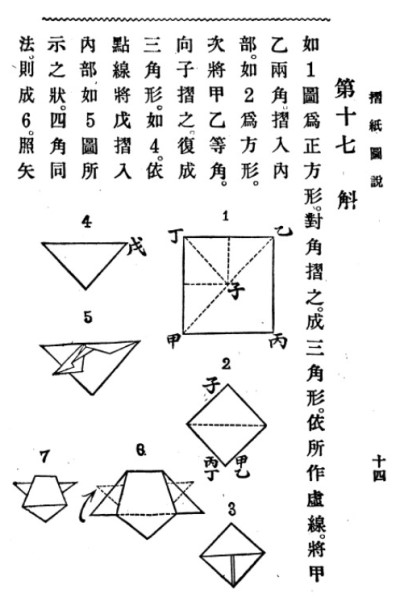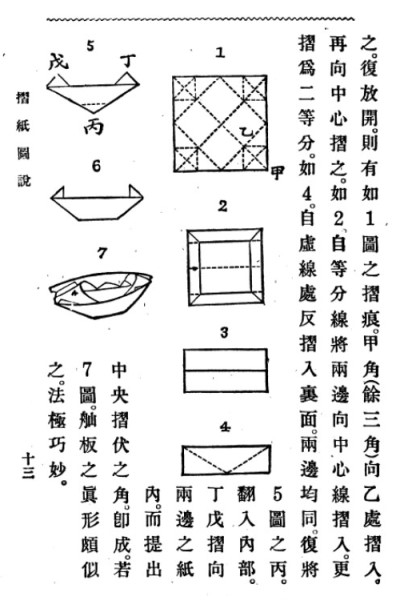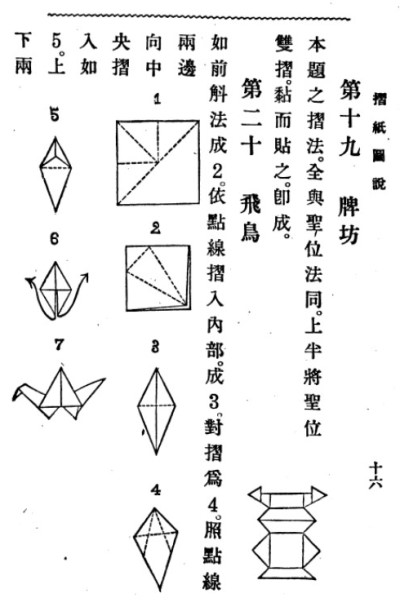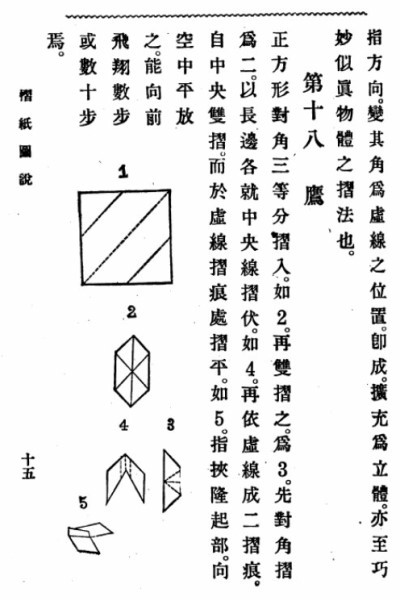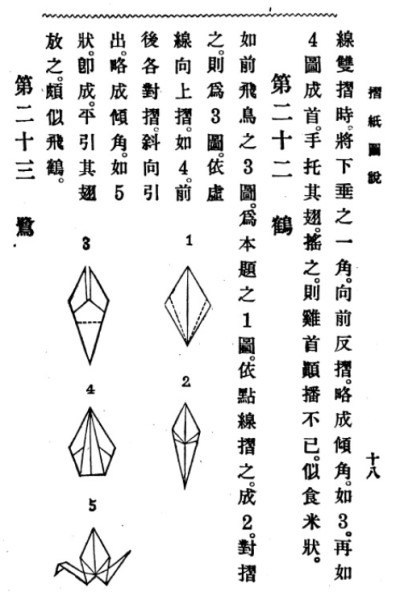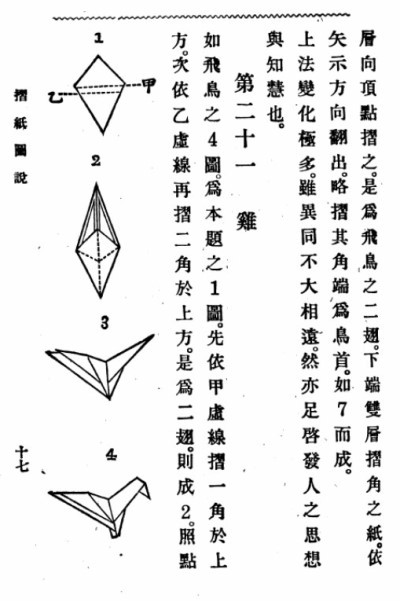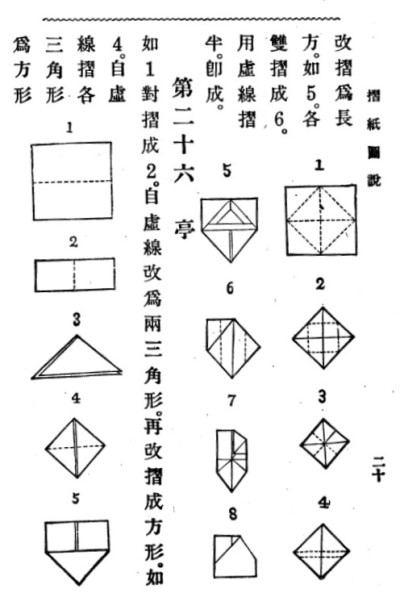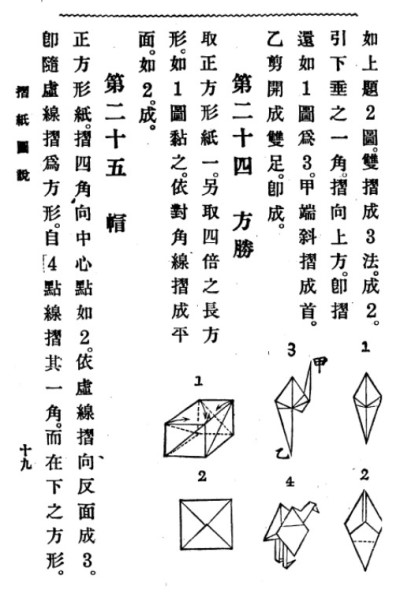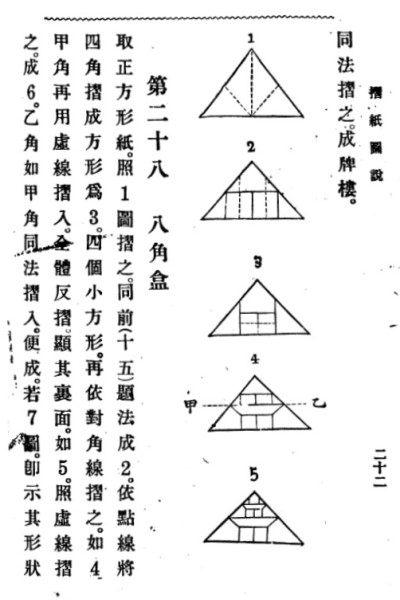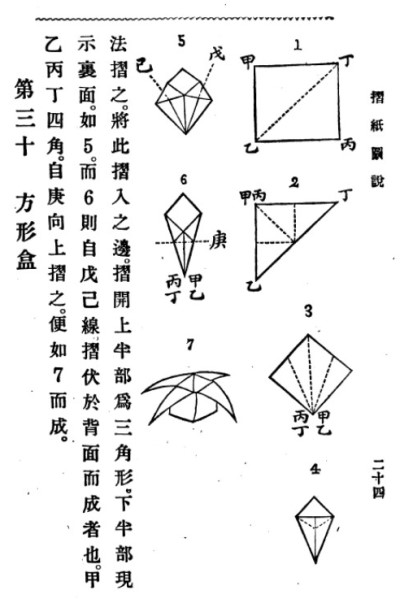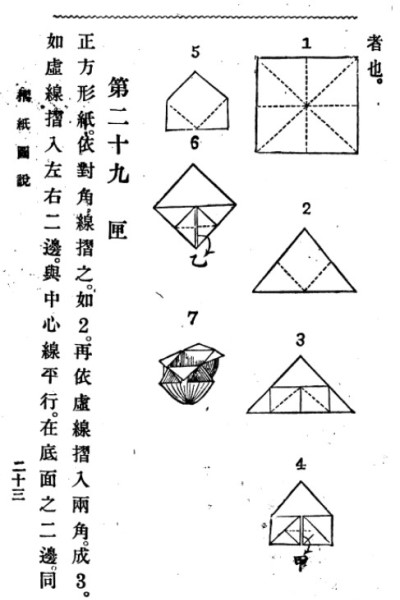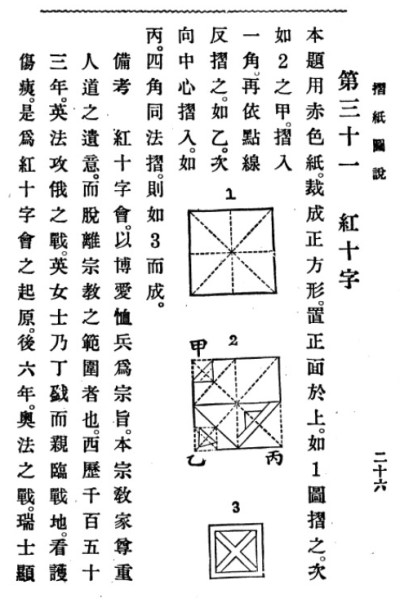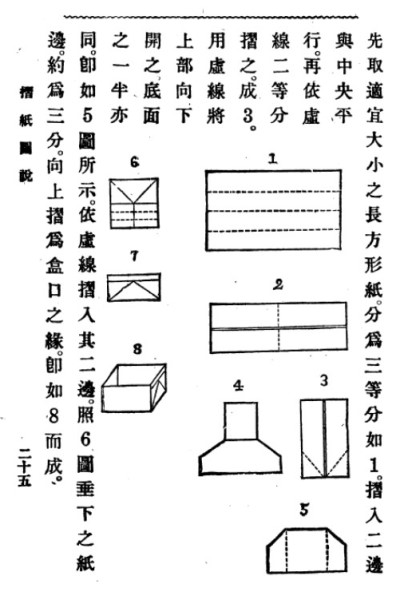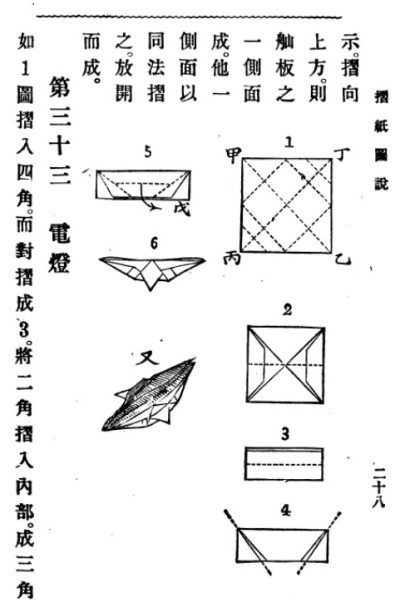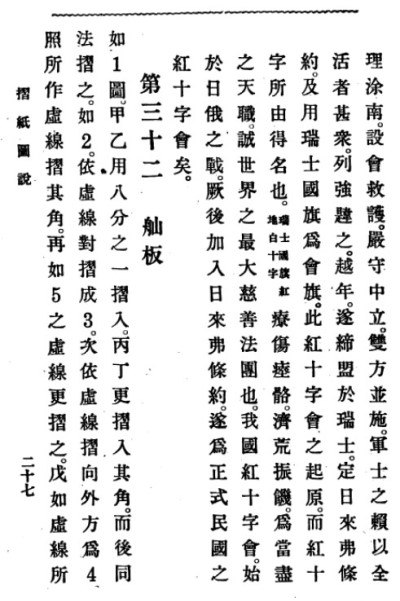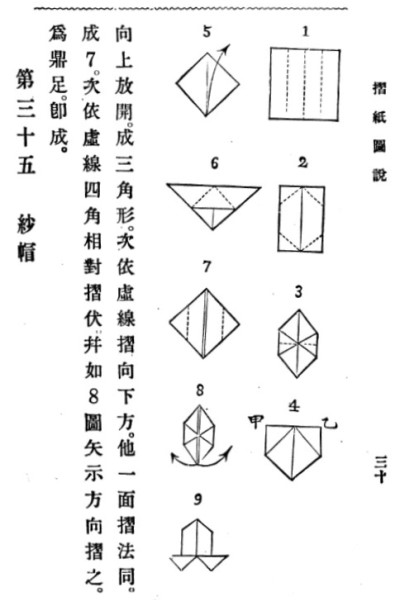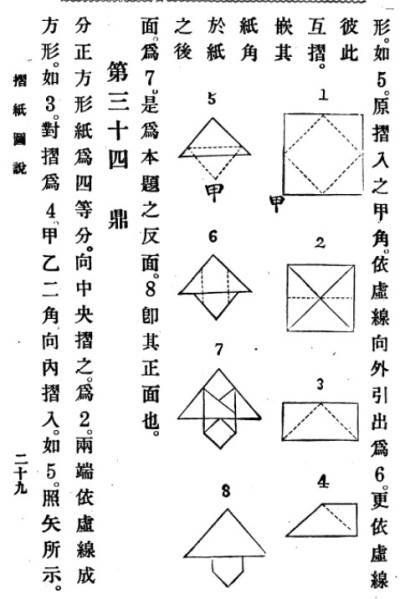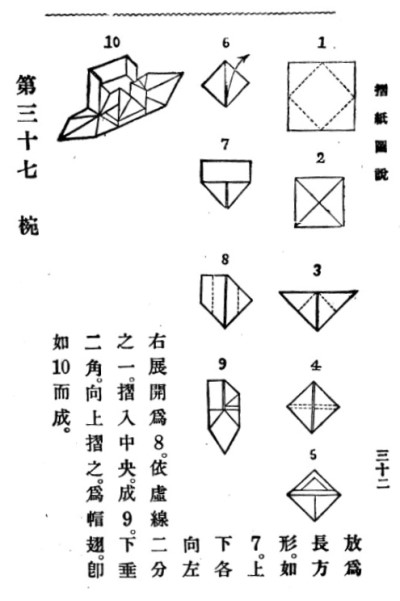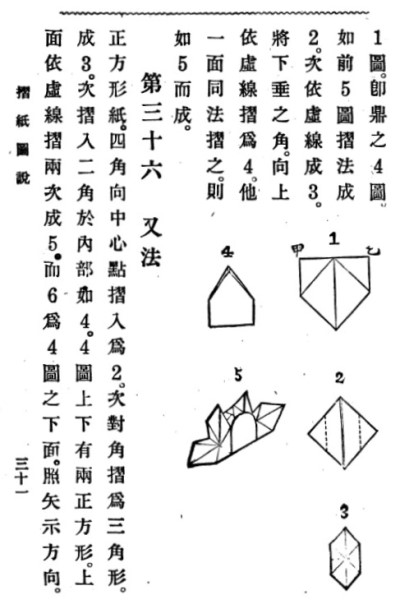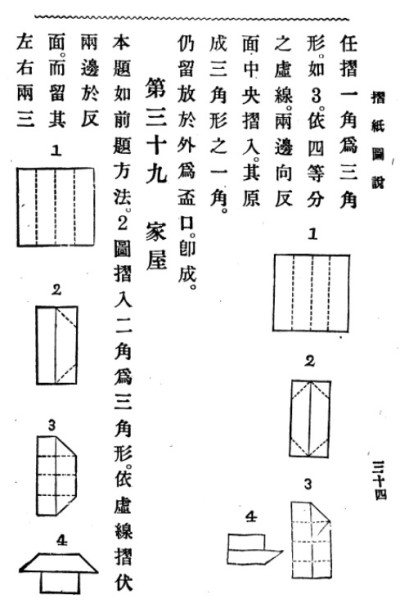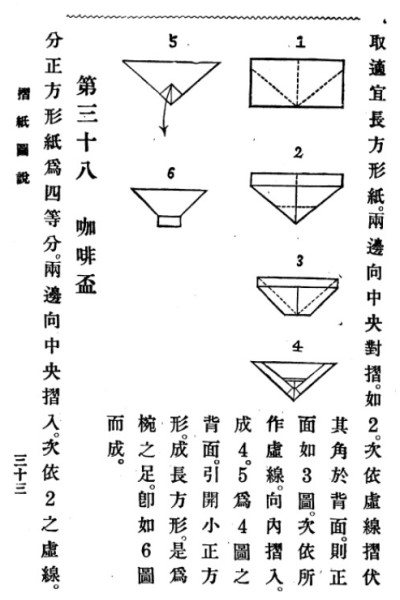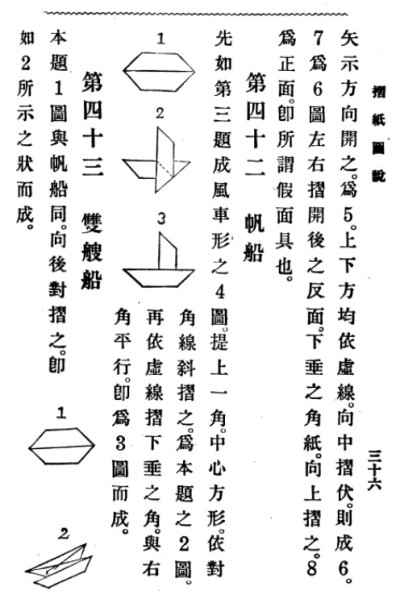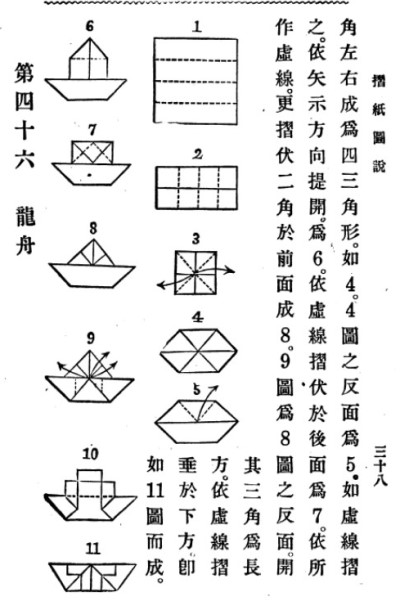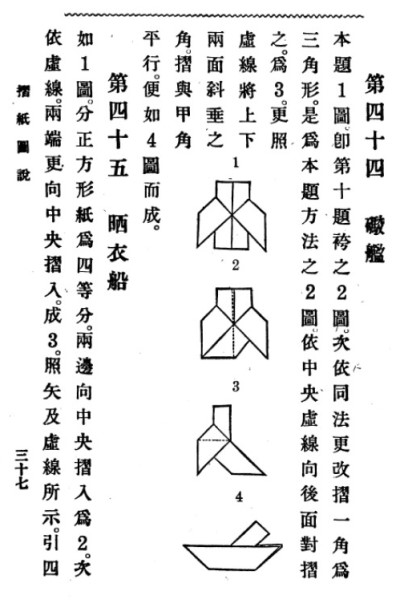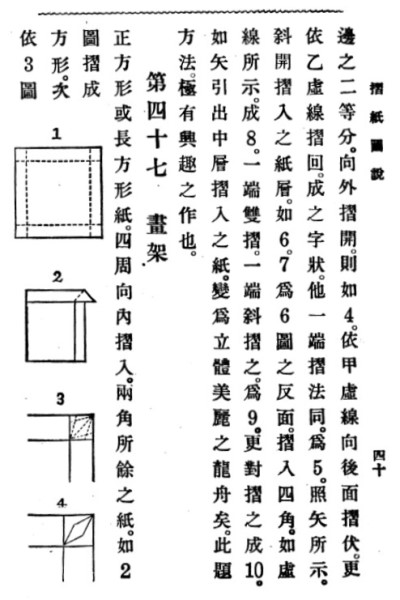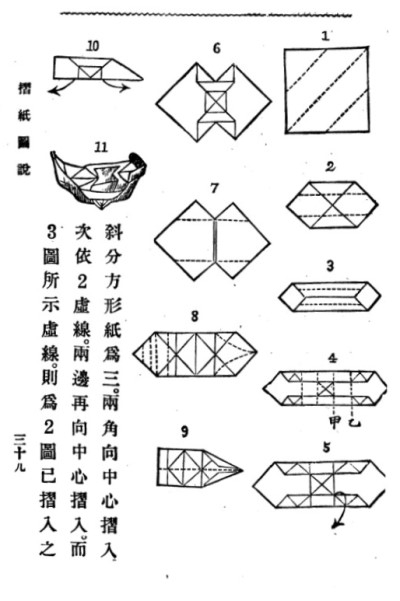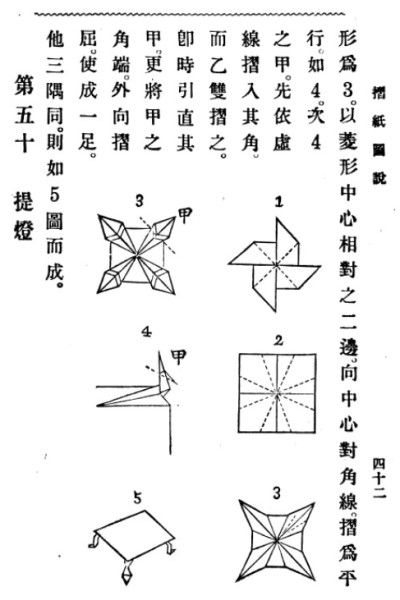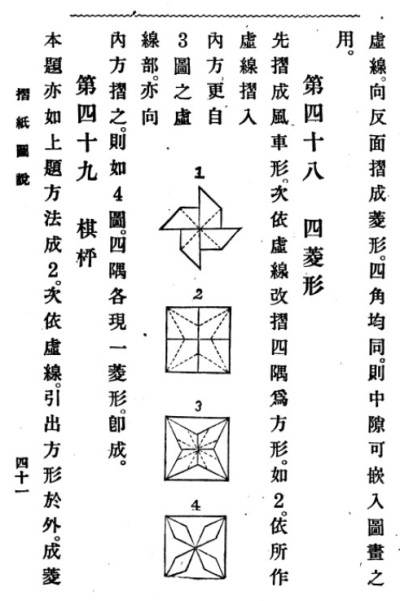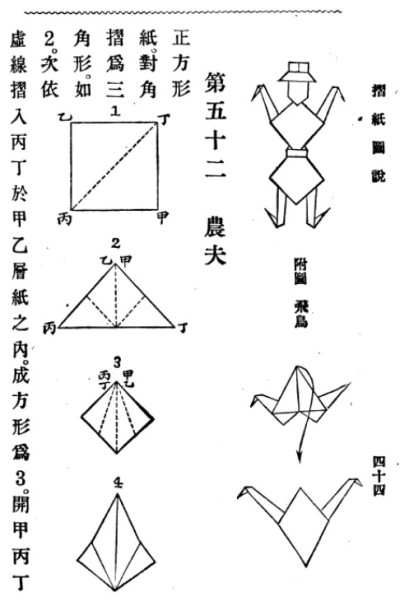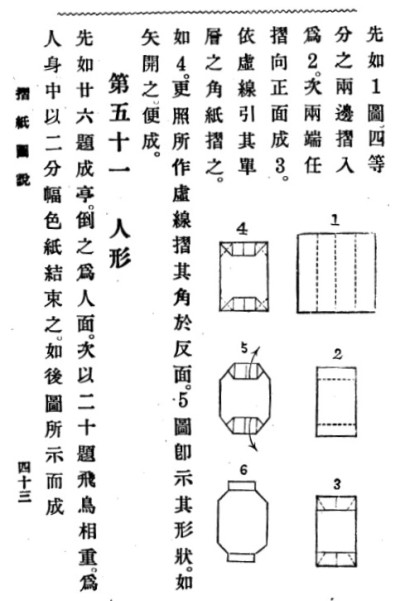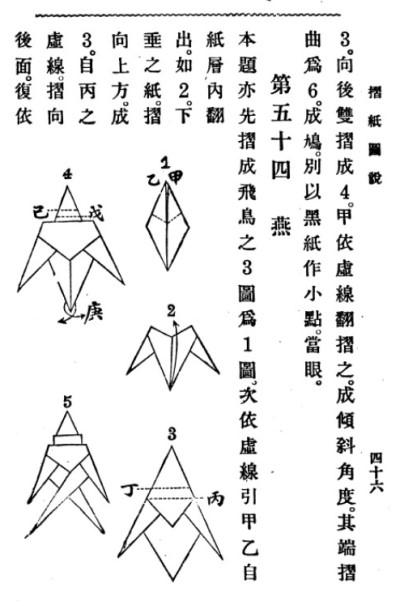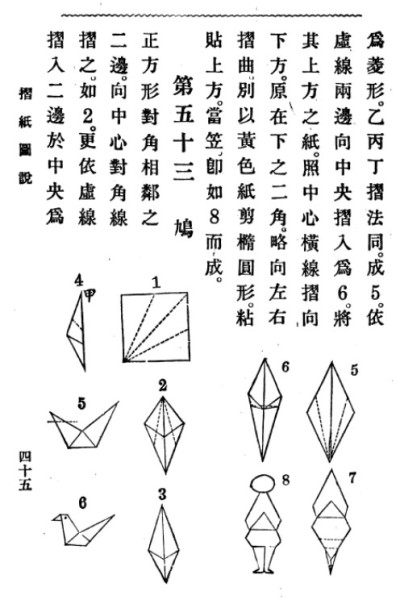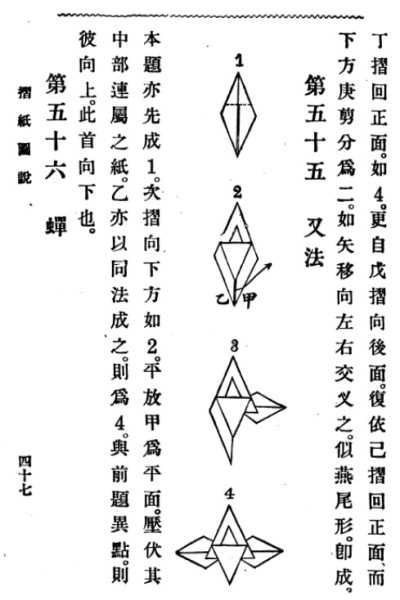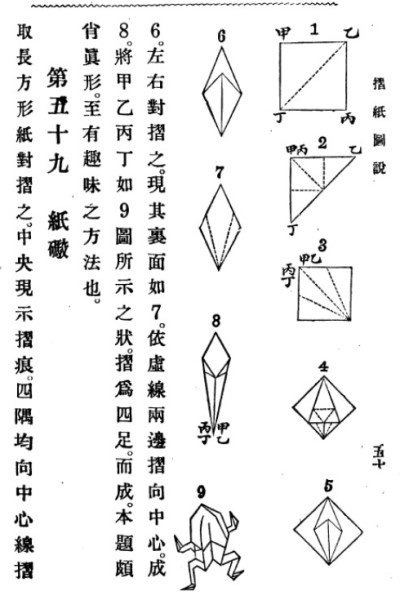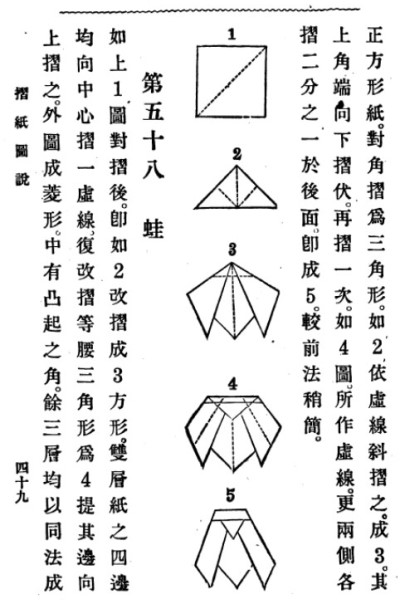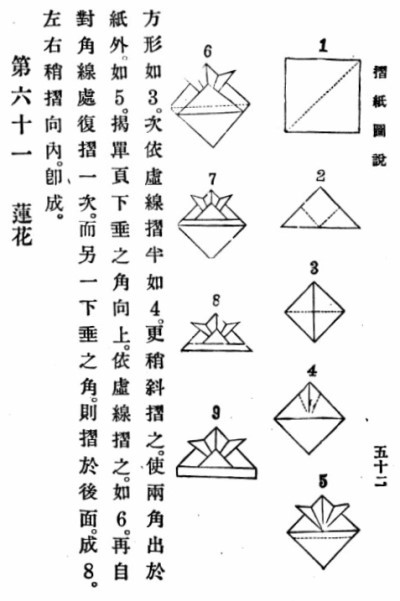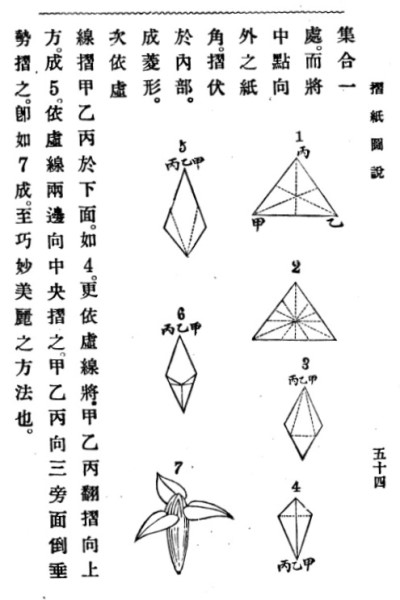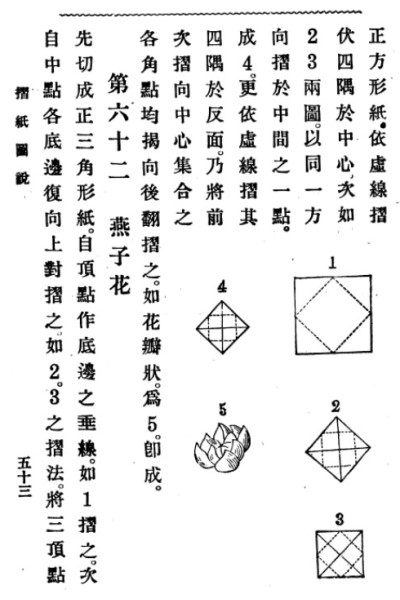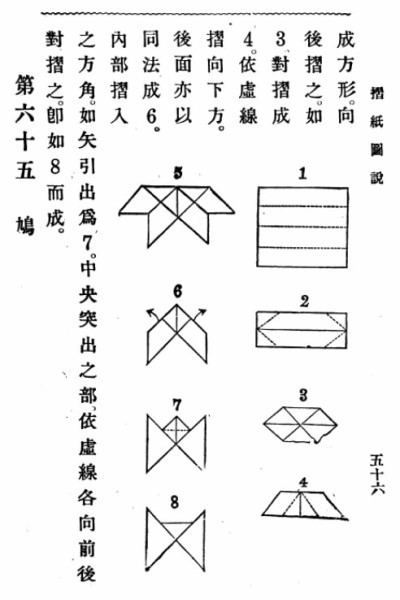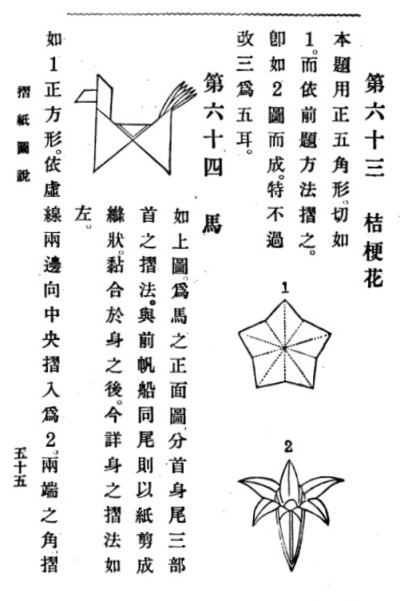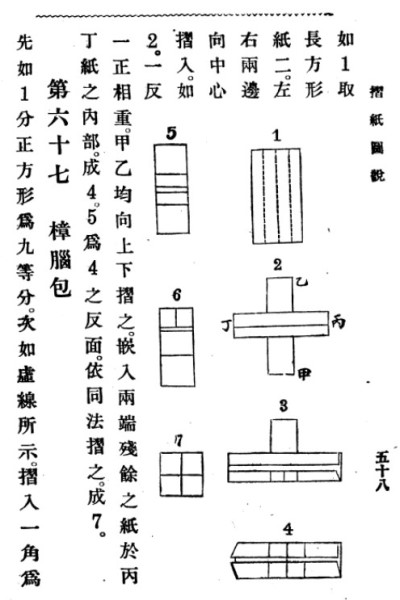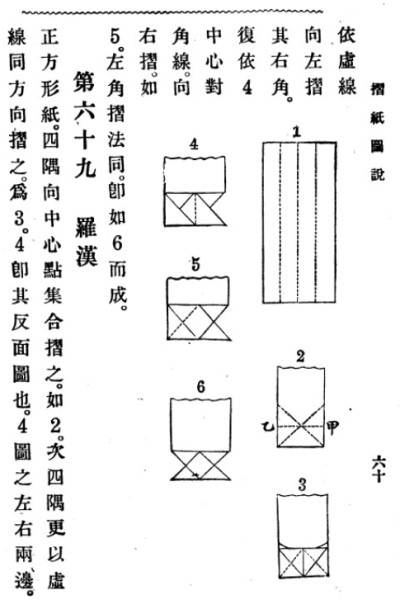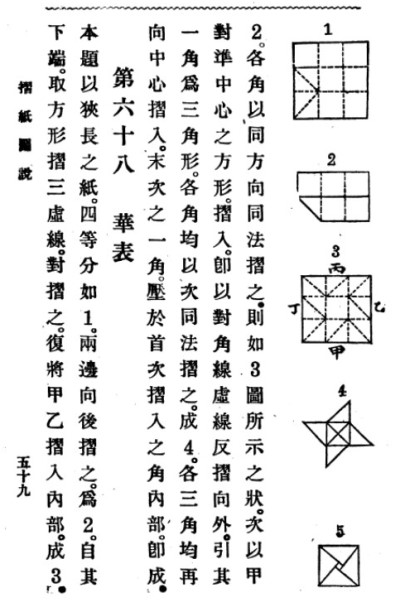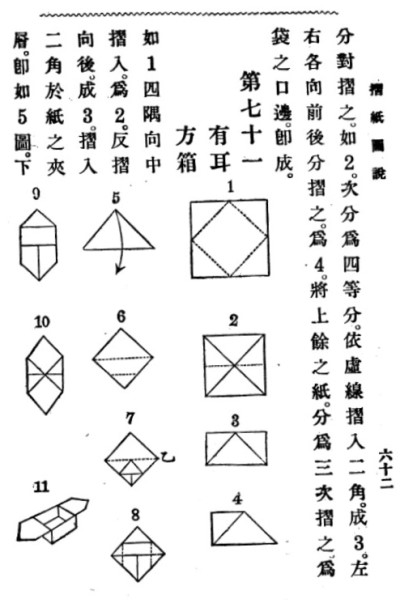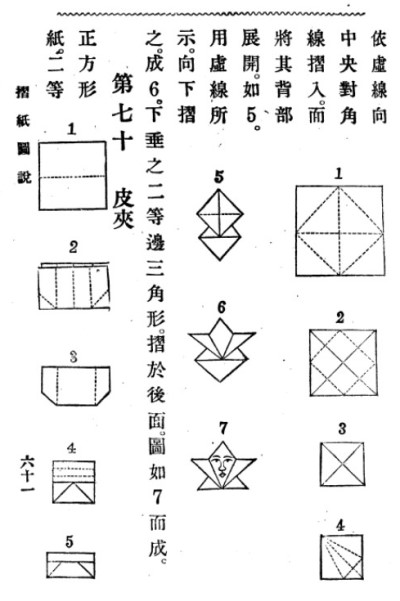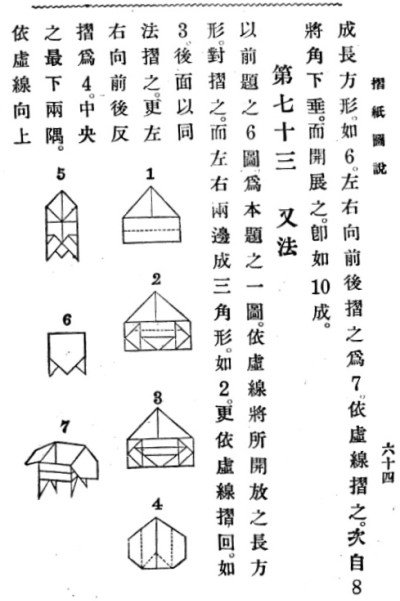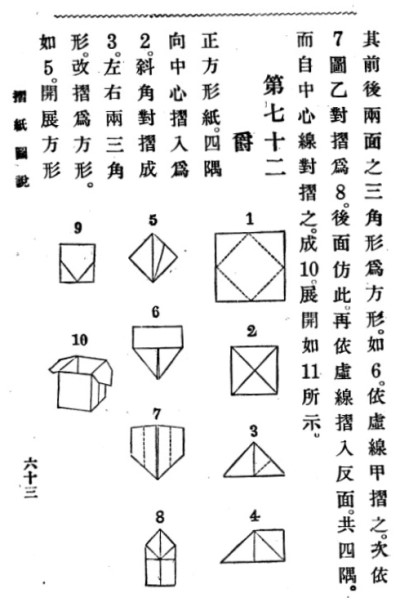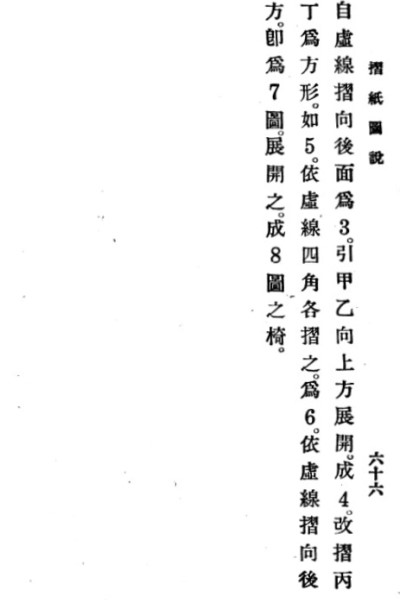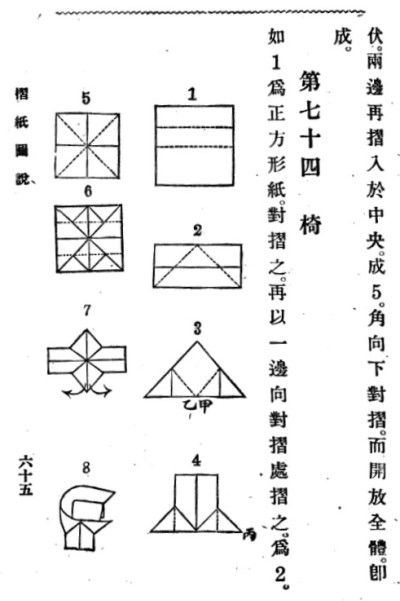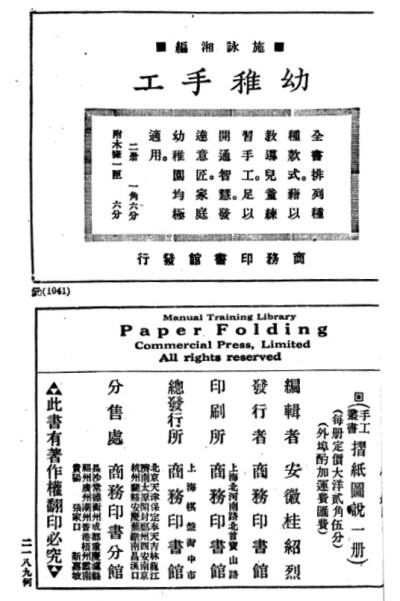| The Public Paperfolding History Project
Last updated 1/3/2024 x |
|||||||
| Zhe zhi tu shuo by Gui Shaolie, 1914 | |||||||
'Zhe zhi tu shuo' (Illustrated Paperfolding), Volume 1, compiled by Gui Shaolie, was published by the Commercial Press in Shanghai in Ming guo 3 (3rd year of the Republic of China ie 1914) as a textbook for the first grade of elementary school. The final page states: 'Various styles are arranged in the book to teach children to practice handcraft, which is enough to open up wisdom and develop artisanship. Suitable for both families and kindergartens.' The full original text of the work, including the introduction, index and advertising, is given below. This book may have been called Volume 1 because 'Xu Zhe zhi tu shuo' (More Illustrated Paperfolding) by Yongxiang Shi, which was published in 1917, may already have been planned.. The final page of the book gives the title and the publisher in English, which might suggest that the work was intended to be distributed in the West. However, there is no evidence that this was the case. Jun Lu has suggested to me that the English words may have been included because the work was published during the period, 1845 to 1943, when Britain and the USA had treaty concessions to trade in Shanghai. As would be expected of works from China of this date, many of the designs in this work are either of Western European and/or Japanese origin. There are, however, a considerable number of designs which are not previously known from either Western Europe or Japan and which may therefore be presumed to have originated in China since the introduction of paperfolding into the educational curriculum via the kindergarten. I am indebted to Michael Naughton for helping me obtain a copy of the work and to Jun Lu for translating, and elucidating, parts of the text, in particular the names of the designs. ********** Analysis In each case I have given an English rendering of the title of the design in this work (in normal font), and, where there is one, my standard name for the design (in bold). The standard name can be used to help you look up more information about the history of the design on the Individual Designs index page. ********** 3. Windmill - The Windmill (Made via the Cigar Case - which is not presented as a design in its own right.)
********** 4. Holy Place (first method) - The Yarn Spool The title probably indicates that the design is being interpreted as a temple. Two different methods of arriving at this design are given. - see no 5 below.
********** 5. Holy Place (second method) - The Yarn Spool
********** 6. Penholder - The King's Crown (Here made in an unusual way via the Muff - which is not presented as a design in its own right.)
********** 7. Monkey - Yakko-san
********** 8. Another Method (of making a monkey)
********** 9. Top Hat / Mandarin Jacket - The Hat / The Shirt The title is Mandarin Jacket. The Top Hat is mentioned in the text. (Made via the Cross, which is not, however, presented as a design in its own right.)
********** 10. The Trousers - The Trousers (Made via the Jacket, which is not, however, mentioned as a design in its own right.)
********** 11. The Stairs - The Stairs
********** 12. Gardenia - The Chrysanthemum
********** 13. Chrysanthemum Box - The Chrysanthemum Box
********** 14. Moth I do not understand how these instructions lead to the final result.
********** 15. Firefly Lamp - The Waterbomb
********** 16. Sampan - The Sampan This appears to be an unusual way of making this design.
********** 17. Dendrobium (a type of orchid)
********** 18. Eagle - The Carrier Pigeon
********** 19. Memorial Arch - made from two Yarn Spools This design is made by glueing two 'Holy Places' (ie Yarn Spools - see no 4 above) together. The top one is folded in half. It must clearly also altered to produce the two 'horns', although this alteration is not mentioned in the text.
********** 20. Flying Bird - The Flapping Bird There is no indication in the text or diagrams that the author knows that the wings will flap if the tail is pulled.
********** 21. Chicken
********** 22. Crane - The Paper Crane
********** 23. Heron - The Cut Heron A cut is used to separate the legs.
********** 24. Box - The Twist Box The text says: 'Take a square piece of paper. Take another 4 times long rectangle paper and glue it up like Figure 1. Fold it diagonally into a plane as shown in Figure 2 and you are done.' The diagrams appear to show a square-section tube produced from a 4x1 strip. Presumably the single square is blintzed then glued in place to create the base of the box, which is then twisted along the diagonals of its sides to collapse it flat.
********** 25. Hat I do not understand the folding sequence or final appearance of this design. The wording says: 'Take a square piece of paper and fold 4 corners towards the center point. It becomes Figure 2. Fold to the opposite side according to the dotted line and it becomes Figure 3. That is, it is folded into a square along the dotted line. Fold one corner of the dotted line as shown in Figure 4, and change the square below into a rectangle. Figure 5. After double-folding, it becomes Figure 6. Fold in half with the dotted line and you're done.'
********** 26. Pavilion - The Pagoda There is no indication in the text that the author is aware that several of these Pavilions can be stacked to produce a Pagoda.
********** 27. Archway - The Archway The final picture in these instructions shows an Archway made by adding a second unit, folded from quarter size paper, to the first.
********** 28. Octagonal Box (Oddly, despite its name, this box is square rather than octagonal, although, seen from above, it does have eight points.)
********** 29. Box - The Star-Shaped Box
********** 30. Square Box - The Collapsible Box
********** 31. Red Cross (The symbol of the International Red Cross organisation.)
********** 32. Sampan (version 2)
********** 33. Lamp
********** 34. Tripod I do not understand how this design is arrived at.
********** 35. Gauze Hat (version 1) Gauze Hats were black lightweight summer hats worn by government officials during the Ming dynasty which had two broad wings on either side of a central cap.
********** 36. Gauze Hat (version 2)
********** 37. Bowl
********** 38. Coffee Mug
********** 39. House - The Japanese House
********** 40. Monk's Hat Simple development of the Japanese House.
********** 41. Face (generic)
********** 42. Sailboat - The Boat with Sail
********** 43. Double Boat - The Double Boat
********** 44. Ship - The Warship Begins with the Jacket
********** 45. Clothes Drying Boat - a version of The Ship
********** 46. Dragon Boat - The Chinese Junk The last sentence of the text says 'The method is very interesting'.
********** 47. Easel Although it is called Easel, this design is more like a picture frame. It is essentially the Four Rhombi design (see below) applied to the edges of a square rather than the square as a whole.
********** 48 . Four Rhombi
********** 49. Chessboard - variation of The Table
********** 50. Lantern - The Long Lantern
********** 51. Doll The head of this figure is the Pavilion, and the two parts of the body are both developed from Flapping Birds.
********** 52. Farmer - The Postman
********** 53. Dove - The Albatross
********** 54. The Swallow - The Cut Swallow
********** 55. Another Way (Another Swallow)
********** 56. Cicada - The Kabuto-Base Cicada
********** 57. Another Way (Another Cicada)
********** 58. Frog - The Blow-up Frog
********** 59. The Paper Popper - The Paper Banger
********** 60. Pocket - The Kabuto The title is literally Pocket but the meaning is Helmet
********** 61. Lotus - The Lotus
********** 62. Swallow Flower - The Iris
********** 63. Bellflower - The Lily (five-petalled version)
********** 64. Horse This is a compound design in three parts. The instructions explain how to make the body. The head and tail are not explained. The head, however, looks like a Boat with Sail.
********** 65. Partridge - The Crow with Legs
********** 66. Business Card Holder - The Business Card Holder
********** 67. Camphor Bag - The Puzzle Purse This design seems to be intended for use as a mothball.
********** 68. Huabiao A huabiao is a kind of free-standing column. This origami representation is very minimalist compared to the highly decorative nature of the real thing.
********** 69. Arhat (one who has achieved Nirvana) - Simple Fukusuke
********** 70. Wallet - The Simple Wallet
********** 71. Square Box with Ears - The Bric-a-Brac Box
********** 72. Sanbo - The Sanbo
********** 73. Another Way - The Sanbo on Legs
********** 74. Chair - The Armchair
********** The Complete Work
********** |
|||||||

